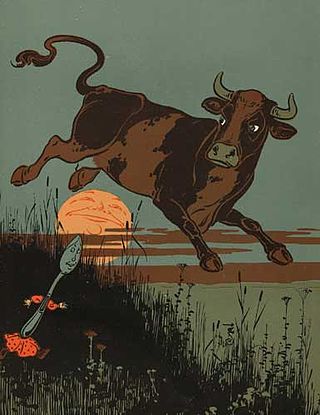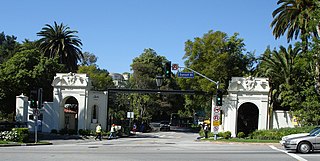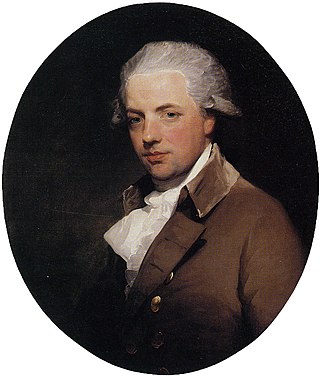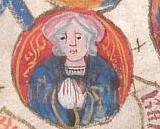
Dame Elizabeth Rosemond Taylor was a British-American actress. She began her career as a child actress in the early 1940s and was one of the most popular stars of classical Hollywood cinema in the 1950s. She then became the world's highest paid movie star in the 1960s, remaining a well-known public figure for the rest of her life. In 1999, the American Film Institute named her the seventh-greatest female screen legend of Classic Hollywood cinema.

"Hey Diddle Diddle" is an English nursery rhyme. It has a Roud Folk Song Index number of 19478.

Bel Air is a residential neighborhood on the Los Angeles Westside, in the foothills of the Santa Monica Mountains in the U.S. state of California. Founded in 1923, it is the home of the Hannah Carter Japanese Garden and the American Jewish University.

Ozias Humphry was a leading English painter of portrait miniatures, later oils and pastels, of the 18th century. He was elected to the Royal Academy in 1791, and in 1792 he was appointed Portrait Painter in Crayons to the King.

Prince William Frederick, Duke of Gloucester and Edinburgh, was a great-grandson of King George II of Great Britain and the nephew and son-in-law of King George III. He was the grandson of both Frederick, Prince of Wales, and Edward Walpole. Prince William married Princess Mary, the fourth daughter of George III.

Catherine Sue Opie is an American fine-art photographer and educator. She lives and works in Los Angeles, as a professor of photography at University of California at Los Angeles.

Fanny Cornforth was an English artist's model, and the mistress and muse of the Pre-Raphaelite painter Dante Gabriel Rossetti. Cornforth performed the duties of housekeeper for Rossetti. In Rossetti's paintings, the figures modelled by Fanny Cornforth are generally rather voluptuous, differing from those of other models such as Alexa Wilding, Jane Morris and Elizabeth Siddal.
Milton H. Greene was an American fashion and celebrity photographer and film and television producer, best known for his photo shoots with Marilyn Monroe.

Catherine of York, was the sixth daughter of King Edward IV of England and his queen consort Elizabeth Woodville.

Henry Dermot Ponsonby Moore, 12th Earl of Drogheda, is a British photographer known professionally as Derry Moore. He inherited the title of Earl of Drogheda from his father, The 11th Earl of Drogheda. He had the right to use the courtesy title Viscount Moore from November 1957 until December 1989.

The Hotel Bel-Air is a boutique hotel located in Bel-Air, Los Angeles, California. The hotel is one of the nine luxury hotels operated by the Dorchester Collection, which is owned by the Brunei Investment Agency (BIA). The hotel has a total of 103 rooms, 45 of which are suites. The Bel-Air hotel has an overall old Hollywood style and is surrounded by 12 acres (4.9 ha) of gardens in the Bel-Air Estates neighborhood.
Robert Hanley "Bob" Willoughby was an American photographer. Popular Photography called him "The man who virtually invented the photojournalistic motion picture still."

Catherine Howard, also spelled Katheryn Howard, was Queen of England from 1540 until 1541 as the fifth wife of King Henry VIII. She was the daughter of Lord Edmund Howard and Joyce Culpeper, a cousin to Anne Boleyn, and the niece of Thomas Howard, 3rd Duke of Norfolk. Thomas Howard was a prominent politician at Henry's court, and he secured her a place in the household of Henry's fourth wife, Anne of Cleves, where she caught the King's interest. She married him on 28 July 1540 at Oatlands Palace in Surrey, just 19 days after the annulment of his marriage to Anne. He was 49, and she was between 15 and 21 years old.
Hilton Als is an American writer and theater critic. He is a teaching professor at the University of California, Berkeley, an associate professor of writing at Columbia University and a staff writer and theater critic for The New Yorker magazine. He is a former staff writer for The Village Voice and former editor-at-large at Vibe magazine.

Earlham Hall is a country house in Norfolk, England. It is located just to the west of the city of Norwich, on Earlham Road, on the outskirts of the village of Earlham. For generations it was the home of the Gurney family. The Gurneys were known as bankers and social activists; prison reformer Elizabeth Fry grew up at Earlham Hall. When the University of East Anglia was founded in 1963, the building became its administrative centre, and it now serves as the law school.
The Gurneys were an influential family of English Quakers, who had a major part in the development of Norwich, England. They established Gurney's Bank in 1770, which merged into Barclays Bank in 1896. A number of family members were abolitionists. Members of the family still live in the United Kingdom.
Catherine Teresa Cookson or Mrs James Cookson was an Irish botanical artist, who documented some of the botany of India.

Brett Whiteley House is a heritage-listed arts and crafts studio and residence in Lavender Bay, North Sydney Council, New South Wales, Australia. It was built during 1905 by Henry Green. It is also known as Brett Whiteley House and Visual Curtilage and Lochgyle. It was added to the New South Wales State Heritage Register on 23 March 2018.
The Casa Encantada at 10644 Bellagio Road in Bel Air, Los Angeles is a large detached neoclassical style house completed in 1938. It was designed by James Dolena with interiors and furnishings by T. H. Robsjohn-Gibbings. It has twice established a record for the most expensive house sold in the United States.

The Pelican Portrait is an oil painting of Elizabeth I of England on a wood panel, named for the pelican pendant shown on Elizabeth's breast. It is generally attributed to Nicholas Hilliard, on the basis of a scientific study and similarities to his other work.














